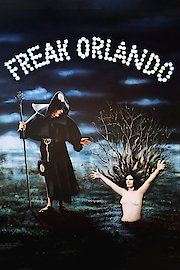-
Genres
-
CastMagdalena MontezumaDelphine SeyrigAlbert Heins
-
DirectorUlrike Ottinger
-
Release Date1981
-
Runtime2 hr 6 min
-
LanguageGerman
-
IMDB Rating5.9 (367)

Freak Orlando is a German experimental film directed by Ulrike Ottinger and released in 1981. It stars Magdalena Montezuma as the eponymous protagonist, a gender-shifting character who travels through time and space and undergoes various transformations in order to explore human identity and the social constructs that govern it. The film also features Delphine Seyrig and Albert Heins in supporting roles.
Freak Orlando is a highly stylized and surrealistic work that combines elements of myth, fantasy, and history to create a visually stunning and intellectually provocative cinematic experience. The film is divided into several interconnected episodes that follow the various incarnations of Orlando as she/he moves through different cultural and historical contexts, from ancient Greece to contemporary America.
One of the most striking features of Freak Orlando is its use of elaborate costumes, makeup, and set design to create a dreamlike and otherworldly atmosphere. Each episode of the film is distinguished by a distinctive visual aesthetic that reflects the cultural and historical milieu in which it is set. For example, the opening sequence features Orlando as a Greek mythological figure, adorned in a dazzling array of colorful fabrics and jewelry that evoke the opulence of ancient Athens.
As the film progresses, Orlando undergoes a series of transformations that challenge conventional notions of gender and sexuality. In one memorable scene, she becomes a bearded lady in a traveling circus, performing for a fascinated audience. In another episode, she is a wealthy European aristocrat who falls in love with a young artist and becomes his muse. Throughout these episodes, Orlando is often subjected to ridicule and persecution, as her/his unconventional appearance and behavior mark her/him as a social outcast.
Despite the fantastical nature of its subject matter, Freak Orlando is deeply rooted in historical and cultural research. Ottinger, who also wrote the screenplay, drew on a variety of sources, including classical literature, art history, and anthropology, to create a highly original and thought-provoking work of cinematic art. The film can be seen as a critique of rigid social norms and a celebration of the creative possibilities of identity transformation.
One of the most interesting aspects of Freak Orlando is the way in which it blends genres and styles to create a unique and highly personal vision. The film combines elements of fantasy, satire, and documentary to create a hybrid form that defies easy categorization. At times, the film feels like a surrealistic fairy tale, full of strange and wonderful creatures and situations. At other times, it feels like a biting social commentary, exposing the dark underbelly of human prejudice and conformity.
Overall, Freak Orlando is an audacious and highly imaginative work of cinematic art. It pushes the boundaries of conventional filmmaking and challenges viewers to question their own assumptions about identity and society. Despite its challenging subject matter and experimental style, the film is also accessible and engaging, thanks to the fantastic performances of its leads and the richness and complexity of its visual and narrative elements. Anyone interested in experimental cinema, gender studies, or cultural history will find much to admire and enjoy in this remarkable film.
